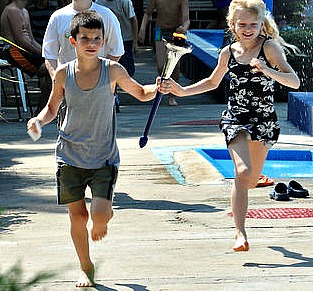Proper running form is attainable only under barefoot conditions.
Young runners who run in shoes land differently on their feet than young runners in habitual barefoot populations. That is, young shod runners heel strike (unsafe), young barefoot runners forefoot strike (safe).

Why Barefoot is Best for Young Runners
A study by McClaren et al. found that barefoot young individuals relied heavily on plantar tactile information for proper foot strike sense meaning that plantar mechanical stimulation coupled with perceived support surface resulted in the most optimal foot strike.

In shoes however, the plantar tactile receptors responsible for mediating safe landings are in a sense blocked resulting in faulty information regarding foot strike awareness.
The researchers also speculated that running shoes caused young runners to rely more on muscle receptor information to compensate for the loss of plantar tactile input. Is this bad? Obviously yes because the end result was a decline in foot strike sense under shod conditions.
Another problem is the longer a young runner wears shoes, the more likely the plantar tactile receptors may weaken – if you don’t use it, you lose it – This could affect how sensory information related to foot strike sense during running is transmitted through the nervous system.
To remain strong, and well-functioning, sensory receptors need a constant flow of sensory traffic, which ultimately strengthens the relation between stimulus amplitude and its perceived magnitude. This is how habitual barefoot runners are able to consistently maintain great form without the risk of repetitive stress injury.
Cushioned running shoes force young runners to diverge from the natural forefoot running technique. Such footwear essentially causes young runners to be insensitive to plantar cues that would have led to better biomechanics. As a result, they never discover the proper way to run and remain stuck in a running style that often accompanies injury and poor performance in adulthood.
More From Run Forefoot:
Forefoot Running Reduces Bone Stress
Backward Running Drills Refines Forefoot Landing
Midfoot Strike Running: Things to Consider
Definition of the Center of Mass and How it Relates to Running Performance
References:
McClaren J., Robbins SE and Waked, E. Proprioception and stability: foot position awareness as a function of age and footwear. Age and Aging, 1995; 24.1, p.67.
Stevens SS. On the psychophysical law. Psychol Rev 1957;64:153-81.
Bretta Riches
BSc Neurobiology; MSc Biomechanics candidate, ultra minimalist runner & founder of RunForefoot. I was a heel striker, always injured. I was inspired by the great Tirunesh Dibaba to try forefoot running. Now, I'm injury free. This is why I launched Run Forefoot, to advocate the health & performance benefits of forefoot running and to raise awareness on the dangers of heel striking, because the world needs to know.
Latest posts by Bretta Riches (see all)
- Cushioned Running Shoes Found to Be Bad for Ankles - 23/04/2024
- Forefoot Running and Achilles Pain - 19/04/2024
- Does Foot Strike Really Matter in Running? YES! - 17/04/2024

Leave a Reply